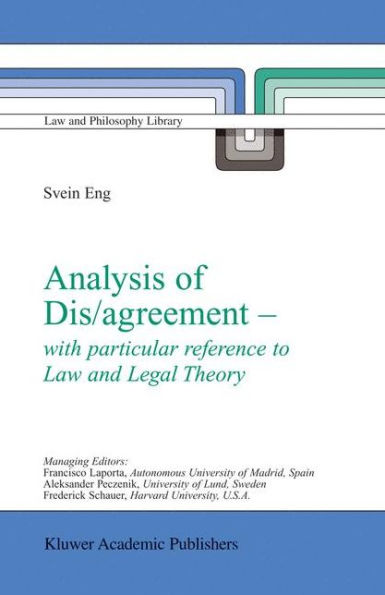Analysis of Dis/agreement - with particular reference to Law and Legal Theory
In order to determine whether two participants in a discussion are in real dis/agreement, one must compare their propositions. Comparison presupposes yardsticks in common. Analysis of Dis/agreement thematises such yardsticks, in that it demonstrates the existence, content and factual significance of a relatively well-delimited set of proposition types and proposition patterns, with their accompanying tenability criteria and motivating interests. The book is a work in the field of legal theory by virtue of its demonstrating how lawyers' power of judgement is constituted in and through these yardsticks. The book is interdisciplinary by virtue of its demonstrating how the same yardsticks come into play more generally in argumentation formulated in everyday language, i.e. independently of law. And the book is a work in the field of philosophy by virtue of its demonstrating the existence and factual significance of language and argumentation actions with a certain independence in relation to the level of controversial fundamental philosophical positions.
1112168192
Analysis of Dis/agreement - with particular reference to Law and Legal Theory
In order to determine whether two participants in a discussion are in real dis/agreement, one must compare their propositions. Comparison presupposes yardsticks in common. Analysis of Dis/agreement thematises such yardsticks, in that it demonstrates the existence, content and factual significance of a relatively well-delimited set of proposition types and proposition patterns, with their accompanying tenability criteria and motivating interests. The book is a work in the field of legal theory by virtue of its demonstrating how lawyers' power of judgement is constituted in and through these yardsticks. The book is interdisciplinary by virtue of its demonstrating how the same yardsticks come into play more generally in argumentation formulated in everyday language, i.e. independently of law. And the book is a work in the field of philosophy by virtue of its demonstrating the existence and factual significance of language and argumentation actions with a certain independence in relation to the level of controversial fundamental philosophical positions.
109.99
In Stock
5
1

Analysis of Dis/agreement - with particular reference to Law and Legal Theory
610
Analysis of Dis/agreement - with particular reference to Law and Legal Theory
610
109.99
In Stock

Product Details
| ISBN-13: | 9781402014901 |
|---|---|
| Publisher: | Springer Netherlands |
| Publication date: | 08/31/2003 |
| Series: | Law and Philosophy Library , #66 |
| Edition description: | 2003 |
| Pages: | 610 |
| Product dimensions: | 6.10(w) x 9.25(h) x 0.06(d) |
From the B&N Reads Blog
